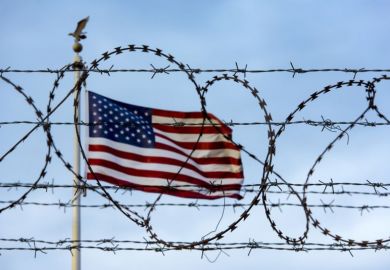At least two dozen US universities have cut tuition fees or other costs for the autumn term, in a churn of institutions struggling to balance student dissatisfaction, educational value and financial risks during the lingering pandemic.
The reductions typically amount to 10 per cent to 15 per cent of tuition fees, and involve institutions of nearly all types and sizes – publics and privates both large and small; tribal, religious and historically black; community college and Ivy League.
Princeton University, explaining its cut from $53,890 (£41,300) to $48,501, said it “remains committed to ensuring that a Princeton education is affordable for every student, even at this time of economic uncertainty”.
Yet the examples of fee givebacks are relatively rare and do not appear to be conditioned on income levels. As such, US universities are staunchly defending the value of online instruction, even in cases where they may be seen as trying to compensate students for it.
Already, US college students and their allies have filed more than 100 lawsuits nationwide, and assembled numerous petitions, accusing colleges and universities of failing to deliver promised benefits this past spring semester and planning to do the same this autumn.
Some of the critics, such as James Toscano, president of the advocacy group Partners for College Affordability and Public Trust, say the Covid-19 crisis has highlighted a long-standing failure by US colleges to provide students with basic consumer protections in an area they have routinely called a career necessity.
“I don’t think on one hand you can preach as a society – and as our institutions have done for decades – that you desperately need to go to college to get ahead in life, and then all of a sudden say, ‘Oh, well, it doesn’t matter what kind of higher education you’re getting,’” he said.
University leaders were pushing back on that narrative, acknowledging the widespread anxiety and pain among students facing Covid-related uncertainties, but suggesting that the grumbling has been disproportionate to any actual loss of educational value from the shift to online teaching.
The University of Maryland Baltimore County is granting the biggest reduction by percentage in the entire country, according to a tally compiled by Dr Toscano’s group, shaving a total of 22 per cent from its autumn semester tuition charges and other fees.
Yet UMBC is adamant that the reduction fully reflects campus-based services that students will not receive or use – such as extracurricular activities and parking – and is not related to any cut-rate valuation of online teaching.
Long before Covid-19’s arrival, UMBC had developed a reputation for using technology to closely track the progress of each of its students to head off academic problems. With the pandemic percolating, UMBC faculty spent “the entire summer” preparing their adoption of online modes, said Lynne Schaefer, its vice-president for finance and administration.
“We’re saying that it is the same quality, it’s just different delivery,” she said.
The share of universities talking of reopening their campuses in the autumn has shrunk steadily from a majority to a minority as the US has failed to control the pandemic.
Beyond those institutions cutting tuition charges or other student fees, dozens of other institutions have frozen costs or postponed planned increases. Many are making case-by-case revisions for individual students. It all looms as a delicate balancing act, as many colleges report large percentages of students choosing to skip the autumn semester.
Register to continue
Why register?
- Registration is free and only takes a moment
- Once registered, you can read 3 articles a month
- Sign up for our newsletter
Subscribe
Or subscribe for unlimited access to:
- Unlimited access to news, views, insights & reviews
- Digital editions
- Digital access to THE’s university and college rankings analysis
Already registered or a current subscriber?








